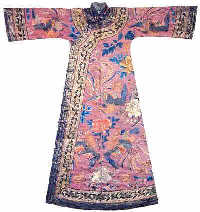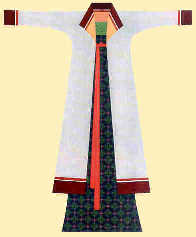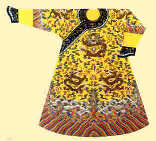 Clothing is the basic requirement for human subsistence, as well as a sign of civilization. It not only satisfies people's need for materials, but also represents cultures at all stages of Chinese history. Politics, economy, culture, religion and customs deeply influence the development of Chinese dress.
Clothing is the basic requirement for human subsistence, as well as a sign of civilization. It not only satisfies people's need for materials, but also represents cultures at all stages of Chinese history. Politics, economy, culture, religion and customs deeply influence the development of Chinese dress.
Clothing, food, housing and transport make up the basic needs of all people. In ancient society, people lived naked in caves. During the New Stone Age people invented the bone needle and began to sew simple winter dress using leaves and animal skins. With the development of society, people engaged in agriculture and began spinning and weaving, even sewing coats with linen. Our ancestors were also engaged in embroidery and made clothing using silk cocoons.
As the living standard increased with the development of economy and culture, the requirements for dress and adornment became more demanding. In the class-structured society, dress became the token of social status. It was from the Xia (21st-17th century BC) and Shang (17th-11th century BC) Dynasties that the dress system came into being in China. In the Zhou Dynasty (11th century-256BC), the system was perfected. From then on distinctions regarding color, design and adornment of dress were made strictly among the emperor, officials and the common people.
China is a multi-national country where each nation has a traditional culture of its own. The mutual support and inspiration among the different nationals made Chinese dress more plentiful and glorious.
 During the Sui (581-618) and Tang (618-907) Dynasties, the economy boomed and the people led a quiet life. The feudal culture of the Central Plains was in a period of great prosperity and people from different countries gathered in Chang'an and Luoyang to promote the international cultural exchange. The culture of middle Asia deeply influences the Chinese dress system.
During the Sui (581-618) and Tang (618-907) Dynasties, the economy boomed and the people led a quiet life. The feudal culture of the Central Plains was in a period of great prosperity and people from different countries gathered in Chang'an and Luoyang to promote the international cultural exchange. The culture of middle Asia deeply influences the Chinese dress system.
The advance of the society brought about the development of Chinese dress and adornment. Each dynasty had a special dress design of its own. For instance, during the Republic of China (1912-1949), the clothes of Manchu women were modified to cheongsams, which were in vogue at that time.
On the other hand, ideology also greatly influenced dress and adornment. During the Warring States Period (475-221BC), when many little kingdoms were competing with each other, the patterns of dress and adornment became plentiful. During the Sui and Tang Dynasties, the unity of a country and prosperous economy brought about new thoughts, making dress more splendid, particularly the décolletage, which also appeared at this time. Because of the intensity of feudal ideology, the patterns of dress and adornment gradually became more conservative in the Song (960-1279) and Ming (1368-1644) Dynasties. Influenced by western cultures, the designs, as well as shoe adornments -- including leather-shoes, heeled shoes and shoes decorated with foreign characters -- were more fitting and tasteful from late Ming.
The patterns of ancient dress were classified into two groups: "coat-and-shirt" and the "one-piece." "Coat-and-skirts" were mainly worn by women and the "one-piece" by men.
 Stringent rules were imposed for the color of ancient dress and adornment. Yellow is the most valuable color, symbolizing the center. Green, red, white and black symbolize the East, South, West and North respectively. Green, red, black, white and yellow are pure colors worn only by emperors and officials. Common people were only permitted to wear secondary colors. With the development of society, dress colors, which are more harmonious and form a partial contrast, replaced that of remote ages, which was very simple. The changes make dress and adornment splendid.
Stringent rules were imposed for the color of ancient dress and adornment. Yellow is the most valuable color, symbolizing the center. Green, red, white and black symbolize the East, South, West and North respectively. Green, red, black, white and yellow are pure colors worn only by emperors and officials. Common people were only permitted to wear secondary colors. With the development of society, dress colors, which are more harmonious and form a partial contrast, replaced that of remote ages, which was very simple. The changes make dress and adornment splendid.
Geometrical patterns and pictures of animals and plants were widely adopted on ancient dress and adornments. Before the Shang and Zhou Dynasties, the patterns were primitive, succinct and abstract. After the Zhou Dynasty, the patterns became much neater. The compositions were balanced and symmetric. During the Tang and Song Dynasties, more attention was paid to composition. From the Ming and Qing Dynasties, most of the patterns were realistic, and the flowers, animals and mountains and waters were all very true to life.
The articles of clothing of past Dynasties are one chapter of China's long history and culture. They are not only the reflection of the politics and economy of a given society, but also great contributions to world civilization.
